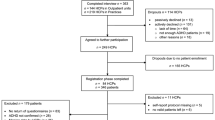Abstract
Background
Continuing Medical Education (CME) plays an important role in quality management, especially as quality assurance, for the improvement of healthcare in child and adolescent psychiatry. This requires responsibility regarding quality standards of clinical practice throughout Europe as outlined by the European Union of Medical Specialists (UEMS).
Objective
Therefore, steps should be undertaken to improve specialists’ medical care and harmonize it in Europe. Attention–Deficit Hyperactivity Disorder (ADHD) with its many co–existing developmental disorders/problems is the central healthcare problem in child and adolescent psychiatry with high impact on society. Therefore, it was chosen as the target.
Method
A European Interdisciplinary Network for ADHD Quality Assurance (EINAQ) was founded, didactic material was developed and a faculty of experts from several European countries established to offer all over Europe harmonized courses on ADHD and associated problems.
Results
Pilot courses were given in Germany in 2003/2004 and were highly appreciated by the participants. Further courses in Germany and other European countries will take place in 2004.
Conclusion
EINAQ seems to be on the right track to be part of CME and specialized networks for healthcare in ADHD to improve the provision for mental health problems in children and adolescents in Europe. Cooperative projects with official European bodies like the UEMS – Section on Child and Adolescent Psychiatry/Psychotherapy and the European Society of Child and Adolescent Psychiatry could strengthen the impact of EINAQ.
Similar content being viewed by others
References
European Union of Medical Specialists (UEMS 2000a) Continuing Medical Education for the Medical Specialist in the European Union. Update on structure of national CME (D 0053-3 annex). Brussels
European Union of Medical Specialists (UEMS 2000b) European Accreditation Council for Continuing Medical Education. Annual Report 2000 (D 0104). Brussels
European Union of Medical Specialists (UEMS 2003) UEMS Policy Paper (draft 6) on Quality Assurance of Clinical Practice (030507). Brussels
European Union of Medical Specialists (UEMS 1994) Charter on Continuing Medical Education in the European Union. Brussels
European Union of Medical Specialists (UEMS 2001) Basel Declaration. UEMS Policy on Continuing Professional Development (0120). Brussels
Gillberg C, Gillberg JC, Rasmussen P, Kadesjö B, Soderstrom H, Råstam M, Johnson M, Rothenberger A, Niklasson L (2004) Co-existing disorders in ADHD – implications for diagnosis and intervention. Eur Child Adolesc Psychiatry 13(Suppl 1):I80–I92
Rothenberger A (2001) The Training Logbook of UEMS Section/Board on Child and Adolescent Psychiatry/Psychotherapy (CAPP) – progress concerning European harmonization. Eur Child Adolesc Psychiatry 10:211–213
Standing Committee of European Doctors (CP 2001) Policy Statement on Continuing Medical Education (CME) and Continuing Professional Development (CPD), (083). Brussels
Swedish Medical Association (2001) Better continuing professional developments – an action program in four steps. Stockholm
Taylor E, Sergant J, Doepfner M, Gunning B, Overmeyer S, Möbus HJ, Eisert HG (1998) Clinical guidelines for hyperkinetic disorder. Eur Child Adolesc Psychiatry 7:184–200
Taylor E, Doepfner M, Sergeant J, Asherson Ph, Banaschewski T, Buitelaar J, Coghill D, Danckaerts M, Rothenberger A, Sonuga-Barke E, Steinhausen H-C, Zuddas A (2004) European clinical guidelines for hyperkinetic disorder – first upgrade. Eur Child Adolesc Psychiatry 13(Suppl 1):I7–I30
World Federation for Medical Education (2003) Basic Medical Education. WFME Global Standards for Quality Improvement. WFME, Copenhagen
World Federation for Medical Education. Postgraduate Medical Education (2003) WFME Global Standards for Quality Improvement. WFME, Copenhagen
World Federation of Medical Education (2003) Continuing Professional Development (CPD) of Medical Doctors. WFME Global Standards for Quality Improvement.WFME, Copenhagen WFME website: http://www.wfme.org
Author information
Authors and Affiliations
Corresponding author
Additional information
EINAQ stands for European Interdisciplinary Network for ADHD Quality Assurance. It is led by the authors and is comprised of an independent working group of ADHD experts working in universities, hospitals and private practices who have set a goal to assure quality of care for patients with ADHD. The EINAQ educational initiative is working in partnership with Thompson Advanced Therapeutics Communication and is supported by an unrestricted educational grant from Eli Lilly and Company.
Rights and permissions
About this article
Cite this article
Rothenberger, A., Danckaerts, M., Döpfner, M. et al. EINAQ – A European educational initiative on Attention–Deficit Hyperactivity Disorder and associated problems. European Child & Adolescent Psychiatry 13 (Suppl 1), i31–i35 (2004). https://doi.org/10.1007/s00787-004-1003-9
Issue Date:
DOI: https://doi.org/10.1007/s00787-004-1003-9




